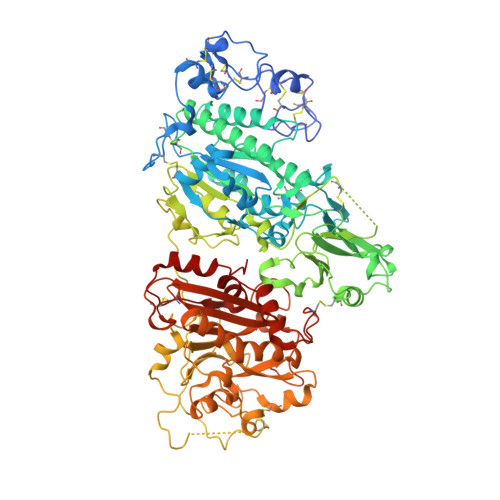Structural snapshots of the catalytic cycle of the phosphodiesterase Autotaxin.
Hausmann, J., Keune, W.J., Hipgrave Ederveen, A.L., van Zeijl, L., Joosten, R.P., Perrakis, A.(2016) J Struct Biol 195: 199-206
- PubMed: 27268273
- DOI: https://doi.org/10.1016/j.jsb.2016.06.002
- Primary Citation of Related Structures:
5IJQ, 5IJS - PubMed Abstract:
Autotaxin (ATX) is a secreted phosphodiesterase that produces the signalling lipid lysophosphatidic acid (LPA). The bimetallic active site of ATX is structurally related to the alkaline phosphatase superfamily. Here, we present a new crystal structure of ATX in complex with orthovanadate (ATX-VO5), which binds the Oγ nucleophile of Thr209 and adopts a trigonal bipyramidal conformation, following the nucleophile attack onto the substrate. We have now a portfolio of ATX structures we discuss as intermediates of the catalytic mechanism: the new ATX-VO5 structure; a unique structure where the nucleophile Thr209 is phosphorylated (ATX-pThr). Comparing these to a complex with the LPA product (ATX-LPA) and with a complex with a phosphate ion (ATX-PO4), that represent the Michaelis complex of the reaction, we observe movements of Thr209, changes in the relative displacement of the zinc ions, and a water molecule that likely fulfils the second nucleophilic attack. We propose that ATX follows the associative two-step in-line displacement mechanism.
Organizational Affiliation:
Division of Biochemistry, The Netherlands Cancer Institute, Plesmanlaan 121, 1066 CX Amsterdam, The Netherlands. Electronic address: [email protected].





















